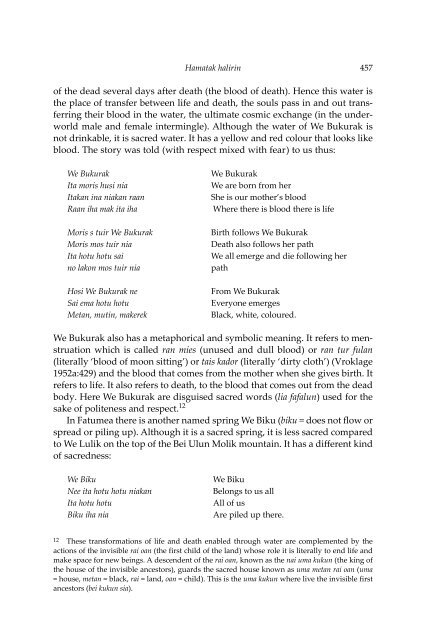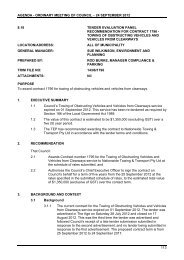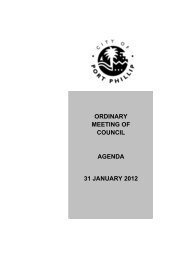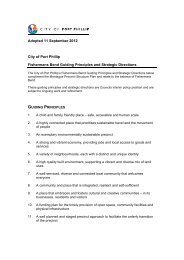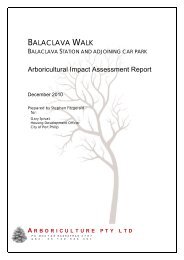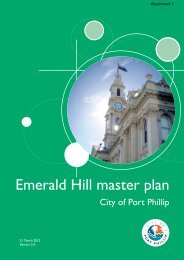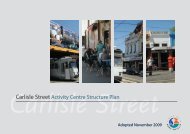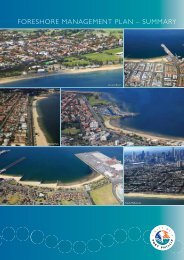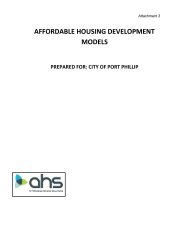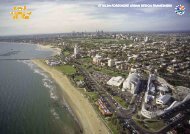Create successful ePaper yourself
Turn your PDF publications into a flip-book with our unique Google optimized e-Paper software.
Hamatak halirin 457<br />
<strong>of</strong> the dead several days after death (the blood <strong>of</strong> death). Hence this water is<br />
the place <strong>of</strong> transfer between life <strong>and</strong> death, the souls pass in <strong>and</strong> out transferring<br />
their blood in the water, the ultimate cosmic exchange (in the underworld<br />
male <strong>and</strong> female intermingle). Although the water <strong>of</strong> We Bukurak is<br />
not drinkable, it is sacred water. It has a yellow <strong>and</strong> red colour that looks like<br />
blood. The story was told (with respect mixed with fear) to us thus:<br />
We Bukurak<br />
Ita moris husi nia<br />
Itakan ina niakan raan<br />
Raan iha mak ita iha<br />
Moris s tuir We Bukurak<br />
Moris mos tuir nia<br />
Ita hotu hotu sai<br />
no lakon mos tuir nia<br />
Hosi We Bukurak ne<br />
Sai ema hotu hotu<br />
Metan, mutin, makerek<br />
We Bukurak<br />
We are born from her<br />
She is our mother’s blood<br />
Where there is blood there is life<br />
Birth follows We Bukurak<br />
Death also follows her path<br />
We all emerge <strong>and</strong> die following her<br />
path<br />
From We Bukurak<br />
Everyone emerges<br />
Black, white, coloured.<br />
We Bukurak also has a metaphorical <strong>and</strong> symbolic meaning. It refers to menstruation<br />
which is called ran mies (unused <strong>and</strong> dull blood) or ran tur fulan<br />
(literally ‘blood <strong>of</strong> moon sitting’) or tais kador (literally ‘dirty cloth’) (Vroklage<br />
1952a:429) <strong>and</strong> the blood that comes from the mother when she gives birth. It<br />
refers to life. It also refers to death, to the blood that comes out from the dead<br />
body. Here We Bukurak are disguised sacred words (lia fafalun) used for the<br />
sake <strong>of</strong> politeness <strong>and</strong> respect. 12<br />
In Fatumea there is another named spring We Biku (biku = does not flow or<br />
spread or piling up). Although it is a sacred spring, it is less sacred compared<br />
to We Lulik on the top <strong>of</strong> the Bei Ulun Molik mountain. It has a different kind<br />
<strong>of</strong> sacredness:<br />
We Biku<br />
Nee ita hotu hotu niakan<br />
Ita hotu hotu<br />
Biku iha nia<br />
We Biku<br />
Belongs to us all<br />
All <strong>of</strong> us<br />
Are piled up there.<br />
12 These transformations <strong>of</strong> life <strong>and</strong> death enabled through water are complemented by the<br />
actions <strong>of</strong> the invisible rai oan (the first child <strong>of</strong> the l<strong>and</strong>) whose role it is literally to end life <strong>and</strong><br />
make space for new beings. A descendent <strong>of</strong> the rai oan, known as the nai uma kukun (the king <strong>of</strong><br />
the house <strong>of</strong> the invisible ancestors), guards the sacred house known as uma metan rai oan (uma<br />
= house, metan = black, rai = l<strong>and</strong>, oan = child). This is the uma kukun where live the invisible first<br />
ancestors (bei kukun sia).


